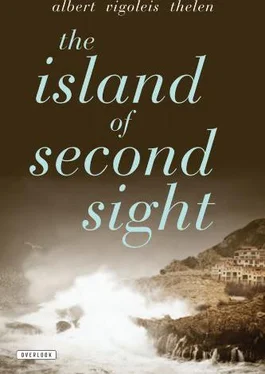My publisher was just here, and told me that he doesn’t intend to produce a first edition of my tome in Dutch. Instead, he wants to take it to market directly in the German original. A Dutch translation would have taken a whole year, and would have lagged behind the original in any case. The book has to come out by the end of November. My manuscript must be finished by June 1. So I’ve got to scribble away faster than ever, seeing as the spirits I call forth always bring new spirits along with them.
Thus the Dutch translation was never completed. But if van Oorschot intended to bring out a German edition, he would have to locate a publishing partner, as he lacked the necessary distributing connections in German-speaking Europe. Thelen understood this, too. On February 1, 1952, he told his brother Ludwig that he could well imagine having his Island come out simultaneously in a German edition:
Unfortunately he [Oorschot] wants to produce an expensive book, a half-bible-paper edition involving Europe’s best typographic artist [Helmut Salden] (incidentally, a close friend of mine), the price, I would say, 12 — 15 marks. I would prefer ro-ro-ro [German publisher of inexpensive novels], and maybe Oorschot can be persuaded. He has never printed books in German. I am his first original German-language author.
Meanwhile Thelen keeps sending chapter after chapter to his brother Ludwig, whose literary judgment he trusts. Ludwig makes corrections and adds commentary, eliciting from Thelen an extremely interesting response:
I have the overall impression from your marginal notes that I haven’t succeeded in giving you as a reader the impression that the “applied recollections of Vigoleis” is a parody of popular memorial literature. Of course I don’t know whether you are familiar with this type of literature. I often plunge ahead and write some exceedingly banal idea, and when I re-read it, I get the impression that what I’ve done is lay on huge gobs of kitsch.
Thus Thelen assigns his work to a definite literary category, linking it with Thomas Mann’s Confessions of Felix Krull, Confidence Man , which was published in 1954. Mann also characterized his book as a parody of popular memoirs.
Work on the manuscript continues unabated at the beginning of 1952. In March he tells Ludwig that he has completed the third of five books, and a month later he announces that he has reached seven hundred pages. But the end is far from being in sight. In May, Thelen predicts a finished work of a thousand pages, and hopes to reach completion by the end of the year. Even though this goal is illusory, in October he takes an important step toward finding a German licensee for his work. On October 18, 1952, he writes to Peter Diederichs, with whom he was corresponding concerning a German edition of Pascoaes’ book on Napoleon:
I would like to speak with you also about the German license for a book of my own. The rights are now owned by the local Dutch publisher G. A. van Oorschot, who intends to publish the book next year in the original German ( The Island of Second Sight. From the Applied Recollections of Vigoleis ). It deals with my years in Spain.
At first Diederichs is skeptical concerning the stipulations of a license, but he agrees to examine the manuscript and, if necessary, to offer advice with regard to distribution. In the meantime, the Dutch publisher is urging Thelen to bring his ever-lengthening work to a close. When Thelen finishes it in February, 1953, it is 1,255 pages long. Diederichs has yet to read a single page, and Thelen cites the work’s size as a reason to delay sending it. He believes that a personal meeting would be the proper way to negotiate, and such a meeting actually takes place at the end of February in Amsterdam. Thelen, Diederichs, and van Oorschot have a three-way discussion. They give attention to the work itself, and in particular to the details of a publishing license. They apparently had partial success, for on March 3 rd, Thelen finally sends the first 126 pages to Diederichs, who now begins reading, as does his wife Ursula, who is pleased with the text. A preliminary decision to go ahead with the printing must have been made in Düsseldorf between March 3 and April 13, for on the 13 th, Thelen writes to Ludwig:
Now it surely looks as if my book will get started together with him [Diederichs]. At least my original publisher van Oorschot wants to see it in German bookstores by November 1 st… I’m going to cut a few hundred pages, paste over a few flecks of midnight oil, and slip in a few sheets of blotting paper. Geert v. O. and I had much fun discussing all this.
When Diederichs finishes reading the manuscript at the end of June, 1953, in his own interest he urges the timely setting-up of a licensing contract. Thelen is of the opinion that in the meantime Diederichs has come to regard the book as economically successful. On August 8, 1953, Thelen reports to his friend and literary colleague Kurt Lehmann:
Diederichs is on board. We drank a toast to our adventure at the Black Hog Inn in Düsseldorf.
With this gesture, the cooperation of the Dutch and German publishers was a fait accompli. The contract itself was very likely unprecedented, since van Oorschot would be producing in his own country a work in a foreign language. The Island of Second Sight appeared in November, 1953 in an original German-language edition in Amsterdam’s van Oorschot Publishers, and simultaneously as a licensed edition in Düsseldorf/Cologne with Diederichs as the publisher. The scene had been set for a successful marketing campaign. Van Oorschot would distribute the thousand-page book in the Netherlands, and Diederichs in Germany, Austria, and Switzerland.
They might have accepted raindrops,
but there came a downpour.
The literary climate in Germany during the first half of the 1950s was determined largely by a literary association called Group 47. Beginning in 1947, the group, which was led by Hans Werner Richter, had convened once or twice a year at various locations to debate literature. At these sessions, young writers read aloud from their works in progress, and following the readings, the attending writers and critics would begin debating the quality of the texts they had heard. The writers who passed muster would enjoy considerable career privileges on the German literary scene, especially among publishers and the media. If today we look at the list of writers who read at Group 47 sessions, we find the names of the most significant post-war German authors, including Heinrich Böll, Günter Grass, Siegfried Lenz, Ingeborg Bachmann, Gabriele Wohmann, Peter Härtling, Peter Handke, and Martin Walser, to name just a few.
Thelen, too, gave a reading in front of Group 47, at their meeting in the Bebenhausen Abbey in Swabia in the fall of 1953. The invitation was arranged by the Dutch writer Adriaan Morriën, who, along with van Oorschot, accompanied Thelen. His performance was a remarkable failure. A few colleagues applauded his reading, but Richter, the Group’s chief spokesman in all likelihood tore Thelen’s text apart. What they had heard, Richter apparently said, would have to be radically revised, since in its present form it could not be published. Thelen later recalled that Richter’s critique culminated in the use of the term Emigrantendeutsch (“an emigrant’s German”). Thelen felt insulted, and in the coming years, he forfeited the support of this influential group, which meant that he would lack the backing that would help him succeed in Germany’s literary world.
Hans Werner Richter’s reaction to Thelen’s Island manuscript reading was, from his own point of view, understandable. Following the war, the young German generation of writers wished to separate itself from the “blood-and-soil” Nazi literary scene as well as from the narrative experiments of the pre-war writers. Their desire was, in theory, to make a wholly new start, “lean and simple, eschewing all tradition, out of fear of yesterday’s soulless language.” Their intention was, in Richter’s words, to carve “a clear-cut through the thicket of our language.” The ambition of Group 47 was to manage as closely as possible this self-imposed set of rules, so anyone who wrote like Thelen could expect to be branded as “behind the times.” Thelen’s baroque style, his enormous vocabulary, and his linguistic virtuosity must have struck these post-war “clear-cut” writers as a relic of times long past. They might have accepted raindrops, but there came a downpour.
Читать дальше












